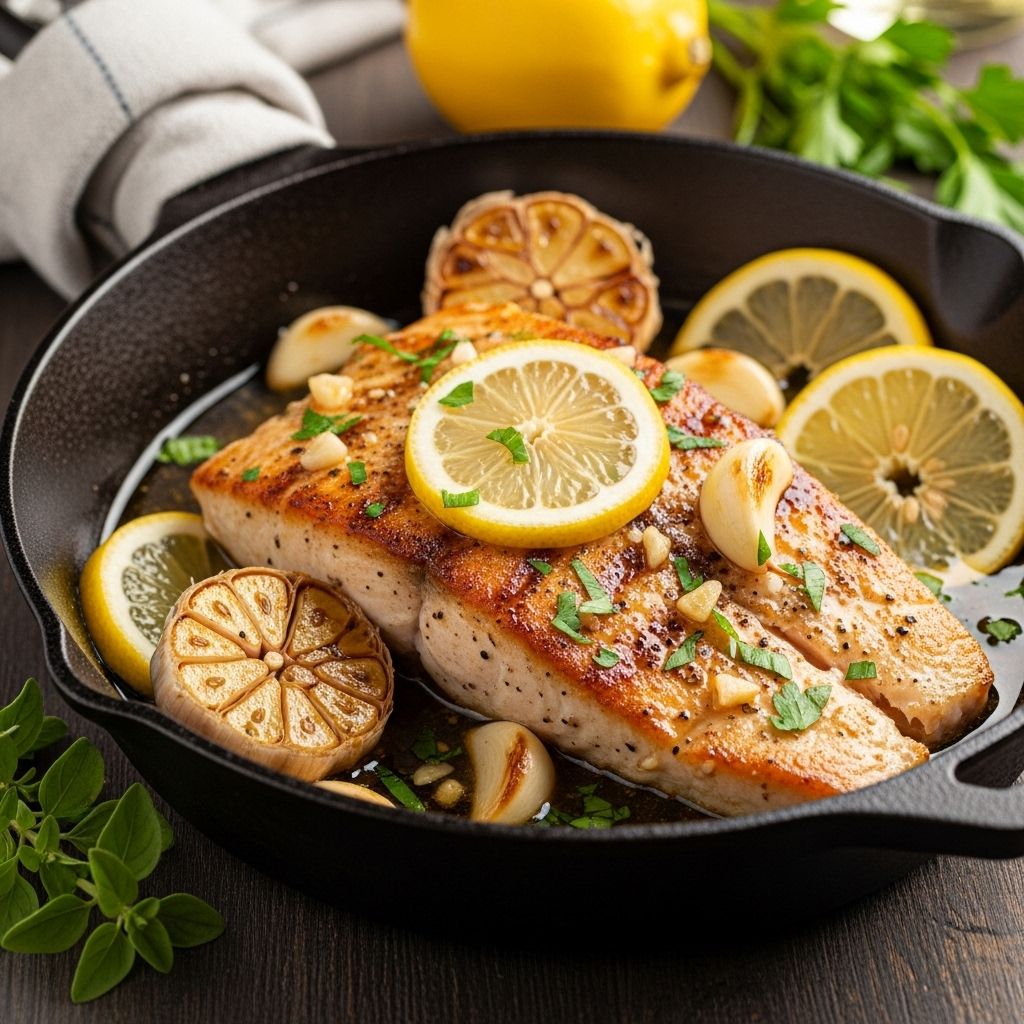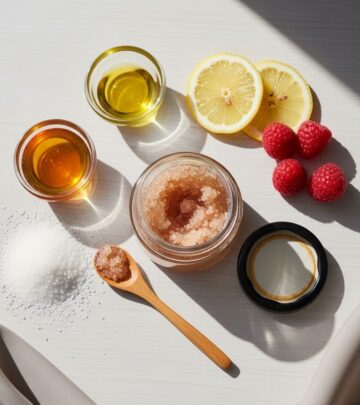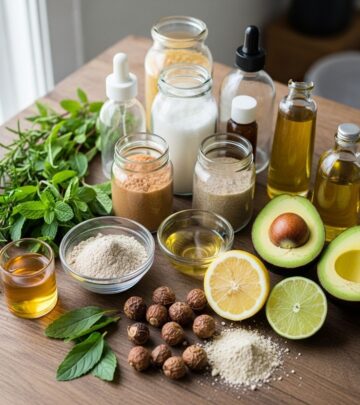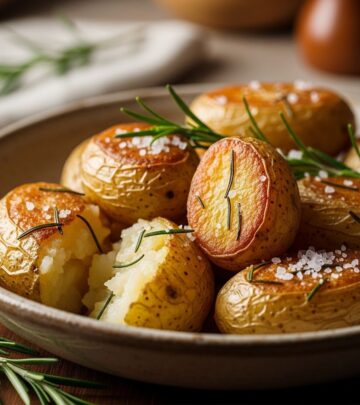Garlicky Lemon Mahi-Mahi: A Quick and Flavorful Skillet Recipe
A zesty one-pan fish dinner with flaky, buttery fillets and crisp-tender vegetables.

Image: HearthJunction Design Team
Garlicky Lemon Mahi-Mahi Skillet Recipe
Few seafood dishes capture the spirit of a healthy, satisfying, and quick meal like garlicky lemon mahi-mahi. With its naturally mild, slightly sweet flavor and firm texture, mahi-mahi becomes the perfect canvas for a lemon-garlic butter sauce. Paired with crisp-tender asparagus, this versatile main dish will shine whether it’s a weeknight dinner or a dinner party centerpiece. Let’s dive into everything you need to know for flawless results—including ingredient tips, step-by-step technique, serving ideas, and expert answers to your top questions.
Why Cook Mahi-Mahi?
Mahi-mahi (also labeled as “dorado” or “dolphinfish” in stores) stands out for its:
- Mild, sweet flavor: Not “fishy,” so it’s enjoyed even by picky eaters.
- Firm texture: Stays flaky but holds together well in the skillet or oven.
- Quick cooking time: Ready in under 20 minutes, perfect for busy nights.
- Versatility: Pairs beautifully with citrus, butter, garlic, fresh herbs, and classic Mediterranean or tropical flavors.
- Nutrition: High in protein, low in fat, and a source of vitamins (B3, B6, B12) and selenium.
Ingredients You’ll Need
This recipe relies on accessible, flavorful ingredients. Here’s what makes each essential (quantities appear in the full recipe below):
- Mahi-mahi fillets: Fresh or thawed from frozen; skinless for best results.
- Butter: Creates a rich sauce base; use unsalted for more control over seasoning.
- Olive oil: Helps prevent the butter from burning when searing the fish.
- Fresh garlic: Delivers bold aroma and flavor to the sauce.
- Lemon: Adds brightness; both zest and juice enhance the sauce.
- Asparagus: Provides a crisp, fresh element next to the tender fish.
- Red pepper flakes: Optional, for a gentle kick that balances the richness.
- Kosher salt and black pepper: Essential for seasoning.
- Fresh parsley: Optional garnish that adds vivid color and herby freshness.
Ingredient Tips & Substitutions
- You can use other tender vegetables like green beans or snap peas in place of asparagus.
- No fresh lemon? Use a splash of white wine for the sauce’s acid element.
- If avoiding butter, substitute with extra-virgin olive oil, though the sauce will be less rich.
Step-by-Step Instructions
This method uses a single skillet for ease and maximum flavor. Each step builds on the last, ensuring nothing is wasted—and you spend less time cleaning up.
- Season and Sear Mahi-Mahi
Pat mahi-mahi fillets dry with paper towels. Season both sides generously with salt and pepper.
Heat 1 tablespoon of butter and 1 tablespoon of oil in a large skillet over medium. Once the butter is melted and bubbly, add fillets. Sear until golden on each side (about 4–5 minutes per side, depending on thickness). Transfer fish to a plate and tent with foil to keep warm.
- Blister the Asparagus
In the same skillet, add the remaining 1 tablespoon of oil over medium-high. Add trimmed asparagus. Cook, tossing occasionally, until bright green and crisp-tender (about 2–4 minutes). Season lightly with salt and black pepper. Transfer asparagus to the plate with the fish.
- Prepare the Garlic-Lemon Butter Sauce
Reduce heat to medium. Melt the remaining 2 tablespoons butter in the skillet. Add minced garlic and, if using, red pepper flakes. Stir often; cook for about 1 minute until fragrant but not browned.
Squeeze in fresh lemon juice (and zest, if desired). Use a wooden spoon to scrape up any browned bits, letting the sauce slightly thicken (about 1–2 minutes).
- Bring it All Together
Return mahi-mahi and asparagus to the skillet. Spoon sauce over top. Cook for another minute just to warm through. Garnish with fresh parsley and additional lemon wedges.
Recipe Summary Table
| Step | Action | Tips |
|---|---|---|
| 1 | Sear mahi-mahi in butter/oil | Don’t move fish until ready to flip—this helps develop a golden crust. |
| 2 | Cook asparagus | Work in batches if needed to avoid steaming. |
| 3 | Make garlic-lemon sauce | Scrape up any flavorful browned bits from skillet. |
| 4 | Combine and serve | Add any juices from the resting fish/veggies to the pan for extra flavor. |
Expert Tips for Perfect Mahi-Mahi
- Pat the fillets dry: This ensures a nice sear and prevents the fish from steaming.
- Don’t overcook: Mahi-mahi is done when opaque and flakes easily (internal temperature ~137°F/58°C). Overcooking makes it dry.
- Deglaze for depth: Adding a splash of white wine or extra lemon juice to the pan can deepen the sauce’s flavor—scrape up every bit.
- Serve quickly: Mahi-mahi is best enjoyed fresh from the pan, so have your plates ready before cooking.
- Customize your sides: Serve with simple grains, crusty bread, or mashed potatoes to mop up extra sauce.
What to Serve with Garlicky Lemon Mahi-Mahi
- Rice: Steamed jasmine, basmati, or brown rice soaks up the citrusy butter sauce.
- Mashed potatoes: Classic, creamy potatoes balance the bright flavors.
- Crusty bread: For dipping in extra sauce.
- Salads: A simple green salad with vinaigrette keeps the meal light.
- Grilled veggies: Zucchini, squash, or bell peppers add color.
- Lemony pasta: Toss cooked angel hair or spaghetti with olive oil, lemon juice, and fresh herbs.
Storing & Reheating Leftovers
Mahi-mahi is best when eaten immediately, but leftovers can be stored safely with these steps:
- Let fish and asparagus cool to room temperature, but no longer than 1 hour.
- Store in an airtight container in the refrigerator for up to 2 days.
- To reheat, gently warm in a skillet over low heat with a splash of water or broth to keep it moist.
- Avoid microwaving at high power, as this can dry out the fish.
- Do not freeze, as the texture of cooked mahi-mahi can suffer.
Frequently Asked Questions (FAQs)
Q: Can I use this recipe for other types of fish?
A: Yes. This method works well with halibut, cod, sea bass, or snapper. Adjust cooking time for thinner or thicker fillets.
Q: Should mahi-mahi be cooked with or without skin?
A: Skinless fillets are recommended for easier searing and serving. If using skin-on, sear skin side down first until crispy.
Q: How do I tell when mahi-mahi is fully cooked?
A: Mahi-mahi is done when it flakes easily with a fork and is opaque throughout. If you use a thermometer, look for 137°F (58°C) at the thickest part.
Q: Can I make this dairy-free or gluten-free?
A: Yes. For dairy-free, substitute olive oil or plant-based butter. The original recipe is naturally gluten-free.
Q: What wine pairs best with garlicky lemon mahi-mahi?
A: Choose dry white wines like Sauvignon Blanc, Pinot Grigio, or a light Chardonnay. Their crisp acidity matches well with lemon and butter.
Pro Variations & Serving Ideas
- Crispy capers: Sauté a spoonful of drained capers in the butter for a briny pop.
- Add tomatoes: Diced cherry tomatoes stirred into the sauce bring sweetness and color.
- Try Italian herbs: Sprinkle in dried oregano or thyme during the garlic step.
- For tacos: Flake cooked mahi-mahi into tortillas with slaw, avocado, and extra lemon sauce.
- Serve with tropical salsa: Top each fillet with mango or pineapple salsa for a Caribbean twist.
Printable Recipe Card
Garlicky Lemon Mahi-Mahi With Asparagus
- Prep time: 10 minutes
- Cook time: 20 minutes
- Total time: 30 minutes
- Serves: 4
Ingredients:
- 4 mahi-mahi fillets (about 1.5 pounds total, skinless preferred)
- Salt and black pepper to taste
- 3 tablespoons unsalted butter, divided
- 2 tablespoons olive oil, divided
- 1 pound asparagus, trimmed
- 4 cloves garlic, minced
- 1/2 teaspoon red pepper flakes (optional)
- 1 lemon (zest and juice)
- Chopped fresh parsley, for garnish
Instructions:
- Pat mahi-mahi fillets dry. Season all over with salt and pepper.
- Heat 1 tablespoon butter and 1 tablespoon olive oil in a large skillet over medium heat. Add fish and cook, turning once, until golden and just cooked through (4–5 minutes per side). Transfer to a plate and tent with foil.
- Add remaining 1 tablespoon oil to skillet. Add asparagus and cook, tossing, until just tender (2–4 minutes). Season with salt and pepper. Move to plate with fish.
- In the same skillet, add remaining 2 tablespoons butter. Add garlic and red pepper flakes; cook, stirring, about 1 minute. Add lemon juice and zest, scraping up any browned bits. Let sauce thicken 1–2 minutes.
- Return fish and asparagus to skillet; spoon sauce over top. Warm through, then sprinkle with parsley and extra lemon wedges. Serve at once.
Nutrition Highlights
| Nutrient | Per Serving |
|---|---|
| Calories | 325 |
| Protein | 33g |
| Fat | 17g |
| Carbohydrates | 7g |
| Fiber | 3g |
| Vitamin C | ~20% DV |
Note: Nutritional values are approximate and depend on exact ingredients used.
Storage & Freezing Advice
- Refrigerator: Store leftovers in an airtight container for up to 2 days.
- Freezing: Not recommended; mahi-mahi can become mealy once thawed.
- Reheating: Use gentle heat and add a splash of water, broth, or extra butter/lemon sauce to prevent dryness.
More Ways to Use Mahi-Mahi
- Mahi-mahi Tacos: Flake leftovers into soft tortillas with crisp slaw, avocado, and extra lemon sauce.
- Bowl-style meals: Serve atop a bed of rice, farro, or quinoa with fresh veggies and drizzle of sauce.
- Pasta addition: Toss into lemony pasta, along with fresh spinach and capers for an Italian twist.
Conclusion
With its winning combination of quick preparation, wholesome ingredients, and restaurant-level flavor, garlicky lemon mahi-mahi with asparagus is poised to be your new favorite fish dinner. Perfect for cooks of all levels, this recipe delivers a satisfying, elegant meal that fits seamlessly into busy lifestyles. Enjoy the bright, buttery sauce, flaky fish, and crisp vegetables any night of the week.
References
- https://www.fromvalerieskitchen.com/mahi-mahi-recipe-lemon-butter-sauce/
- https://thishealthytable.com/blog/baked-mahi-mahi/
- https://carlsbadcravings.com/mahi-mahi-recipe/
- https://www.delish.com/cooking/recipe-ideas/a54224/best-mahi-mahi-recipe/
- https://www.delish.com/entertaining/g20065692/mahi-mahi-recipes/
Read full bio of Anjali Sayee












